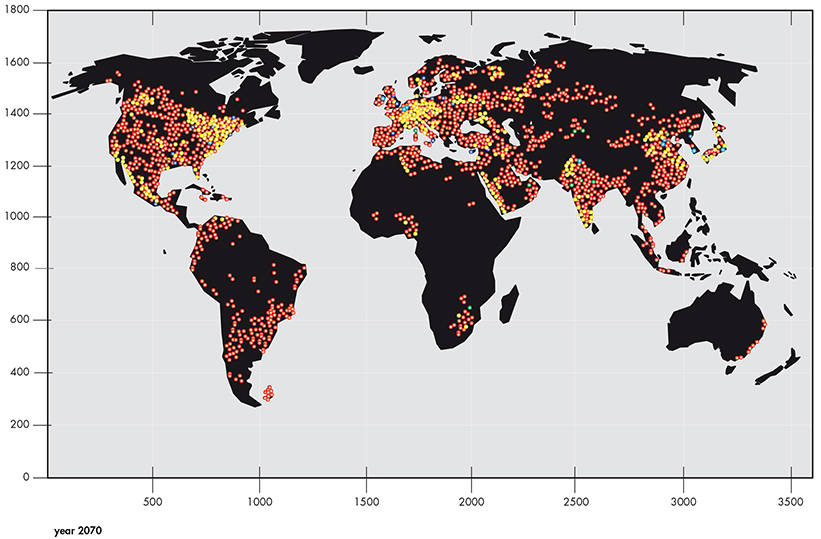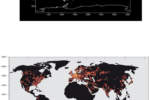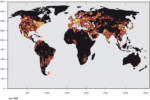The matter of the climatic change
The challenge of two degrees centigrade
It is a known fact that all countries agree on one goal, namely to reduce emissions of carbon dioxide in the atmosphere in order to limit the future increase of the global temperature to two degrees centigrade; beyond this level we would come to cross a critical threshold, of which consequences are universally recognized as catastrophic for the equilibrium of the global ecosystem.
The question is so serious and has received so much attention worldwide that it has been the goal and subject of summits by the G20, the General Assembly of the UN and the Climate Conference held in Durban in South Africa, just to mention some of the latest international meetings (2011).
According to the 4th IPCC (Intergovernmental Panel on Climate Change) Report on the climatic change between 2030 and 2050, it will be necessary to reduce global emissions of carbon dioxide in the atmosphere to a growing extent varying between 30-50%, in order to keep CO2 concentrations within safe levels by the end of the century and thus attain the goal, as ambitious as indispensable, of containing the global warming within the fixed limit of 2 degrees centigrade.
To remain within this limit the global emissions of greenhouse gases should reach their maximum values in 2020 at the latest, with a reduction of at least 50% under 1990 by 2050, after which it should continue to decrease to keep concentrations of CO2 in the atmosphere below a maximum level of 450 ppmv (parts per million by volume). To this end, considering the current demographic projections until 2050, the global average of emissions of greenhouse gases pro capita per year should be reduced to about two tons of CO2 equivalents. It is also necessary to assure a convergence of the national pro capita emissions between developed and emergent countries according to a strategy and methodology of behaviour that should consider the principle of “shared but differentiated responsibility”.
If we to clarify matter compare the data through a column graph (see the image alongside the baseline) and compare the level of emissions that the current trend seems to suggest from now and into the next decades with reference to 2050 – Baseline 2050 –, with the expectations of change that has become necessary, sector by sector, with respect to the CO2 produced – Blue Map 2050 -, we obtain a plastic image of the change. In fact, the Blue Map 2050 column represents the expected scenario, which is a consequence of a global sustainable development in accordance with the report issued by the international energy agency on the technological prospects aimed at favouring economic growth using sustainable energy, that is to say energy obtained from renewable sources. This is the challenge and the main goal for the forthcoming years.
In fact, economic growth, the industrialization of emergent countries and consequently the enormous and new demands for energy of some contexts represent the key, in relation to the production strategies implemented, towards understanding whether a sustainable future where the increase, or desired reduction, of global emissions do not influence the climate, thus creating a system that is dangerous to the future of the planet, is feasible. It is interesting to observe (see the linear graph on the next page) that the increase of greenhouse gas emissions on a global level originate from emergent economies, beginning precisely from China. If we compare the data for the United States of America with the great Asian colossus, we find that China has in the last decade surpassed its competitors across the ocean, and that it is today the country in the world with the highest emissions. Emissions in Western countries seem to decrease while China clearly appears to register an exponential development.
The emissions are growing.
According to the basic scenario of IEA ETP (International Energy Agency – Energy Technology Perspectives), the total demand for primary energy will continue to grow until 2050, reaching 23,268 million TOE (Tons of Oil Equivalent) with a proportionate increase of emissions, equivalent to about 130% over today.
As a result of the economic growth, which has been slowed down but not interrupted by the recent economic-financial crisis, China and India will produce 51% of the incremental demand for primary energy worldwide if we consider the period of 2006-2030, while non-OECD (Organization for Economic Cooperation and Development) will still be responsible for 87% of the increase of the energy demand even if their quota of the global demand for primary energy will increase from 51% to 62%.
Emissions pro capita: an index of the energetic and social gap.
Emissions pro capita in emergent and developing countries are much lower than in the developed world. In 2010 the figure for the United States was three times higher than the one for China, and 15 times higher than that of India.
Emissions pro capita are a perceptible indicator of the energetic and social gap existing between the countries, in which context we may also consider the 2 billion persons in the developing part of the world who do not yet have access to energy. The energy demand will therefore increase most precisely in developing countries, to allow improved life conditions, something which should however be pursued and attained in a sustainable manner in order to avoid the aforesaid effects associated with climatic changes.
Three crucial questions and issues have to be resolved:
– How should we deal with the growing demand for energy of emergent economies, starting with China, India, Brazil?
– How should we deal with the demand for energy without creating an uncontrolled increase of emissions?
– How should we meet the demand for energy of China and the emergent countries and contain, or at least control, the emission of greenhouse gases?
We know there is only one answer to these questions, and therefore only one way out that is sustainable, namely to work incessantly to favour technologies characterized by low carbon emission. We must in other words concentrate all investments and efforts in terms of research and interventions worldwide to develop low-emission technologies, while being aware that the answer is not simple and univocal but variegated and complex; it is in other words a matter of implementing all those strategies which may, with infinitesimal and particular alterations with respect to the general conditions, produce an integral and different sum with respect to the global data.
The technological challenge.
The “BLUE MAP scenario” and the problem of the convergence between pro capita emission values call for an immediate intervention on a global level, which may be tackled if we are conscious of the importance of solving some fundamental strategic aspects that we can summarize in the following programmatic points: – a “sharing of the burden” with reference to the attainment of the peak expected to be reached in 2020, considering the gap, existing and foreseen, in terms of intensity of carbon and pro capita values between the different countries and economies;
– the “revolution” of energy technologies according to agreed and obligatory criteria in the form of international standards (for energy efficiency, sustainable biofuels, renewable performances…) and international regulations to convert the energy system to the use of “zero-emission” technologies (for instance by gradually ceasing to use existing infrastructures that are powered by fossil fuel and that are not equipped with technologies for the capture and storage of carbon dioxide);
– national and international regulations with a commercial and fiscal impact that promotes investments in low-emission technologies and that prevent unfair competition and transfers of emissions of CO2;
– creation and management of international financial mechanisms to promote energy security in developing countries.
As may be easily understood, it is a matter of a new, complex and unprecedented challenge. No past international agreement has succeeded in simultaneously tackling all the aspects necessary to manage the climatic change, the intensity of greenhouse gas emissions produced by the different economies, and energy safety. To appreciate the difficulties associated with the question, it is sufficient to consider that strategies aimed at reducing the “carbon foot print” (CFP) still coexist, according to trends that show no signs of decreasing, with a continuous flow of investments in infrastructures powered by petrol and gas. How is it possible to plan and implement an exit strategy from fossil fuels when tens of billions of dollars are being spent every year to build new infrastructures based on oil, oil sand, natural gas and shale gas? How can we reconcile the prospects of a long-term operation of these infrastructures with the peak of emissions predicted for the year 2020?
A European-Chinese platform for reduction of emissions
A shared European strategy aimed at attaining the goals set for 2050 has been defined during the Durban Summit (December 2011) in order to verify the possibility to adopt measures and rules in order to promote a “decarbonizing” of the economy in such a way as to both sustain the goals of growth and economic development and at the same time pursue the goals of the reduction of emissions. In this perspective, Europe may share the programmed trajectory and the verification of the strategic and methodological with China with the intention of building a ‘global platform’ for the innovation and diffusion of reduced-emission technology, in view of the fact that it is precisely Europe and China that are making the greatest investments in terms of use and incentivation of technologies that make it possible to reduce carbon emissions.
In 2011 a new record was set for worldwide investments in “clean” energies, that is to say energies produced by non-fossil fuels. A total of 260 billion dollars were invested, which represents a 5% increase over 2010 and is five times higher than the amount invested in 2004, i.e. 53.6 billion dollars.
All this enable us to look at the future with optimism, especially because the figure for 2011 has been registered in a year in which the world economy as a whole has faced serious difficulties, and also the sector of “clean energies” has been especially affected by the crisis with considerable pressure on the manufacturers’ profit margins, followed by a drastic drop in the share values of some major corporations, which have also suffered the effects of the cuts of subsidies by the European governments and the reduced credits available from leading banks.
Subdivision of investments in renewable-source energy production in 2011 by typology.
The type of investment that has registered the highest amount of funds aimed at backing projects in the “clean energy” sector mainly concerns interventions associated with public services, which has registered a substantial increase, reaching a figure of 145.6 billion dollars invested in 2011, which is about 5.07% higher than the total amount registered in 2010, i.e. 138.3 billion dollars. The second category in order of economic importance concerns funds provided for a diffused installation of renewable-energy technologies, especially photovoltaic panels which have mainly been installed on roofs; the absolute values registered show an increase in total investments from 60.4 billion dollars in 2010 to 73.8 billion in 2011. The third in this special hit list of economic merit is the sector of technologies that make it possible to save energy, which comprises smart grids, energy storage, optimized and advanced transports; these sectors show significant results that may be valued as more than 19.2 billion for 2011.
The performance of investments in solar energy technologies
Total investments in the installation of solar energy technologies for the direct production of energy and heated water have reached an amount of 136.6 billion dollars in 2011, i.e. almost twice the resources dedicated to wind energy that only reach 74.9 billion, which represents a drop of 17% as compared to the previous year. The performance of the solar sector deserves particular attention, because if we consider that the price of photovoltaic elements has dropped by almost 50% in 2011, with prices that are 75% lower than they were only three years ago, it means that the same investment makes it possible to install very large and constantly increasing quantities, both in terms of square metres and, consequently, in terms of energy produced. The volume of photovoltaic installations has increased at a much higher rate than other energy sources precisely because the competitiveness of this technology is reaching, and in some cases overtaking, performances that could previously only be achieved with other production methods. The menace of the climatic change and the necessity of an overall adaptation of the systems of prevention.
In the last decade many regions and countries have been affected by extreme events in the form of natural catastrophes that have entailed immense economic costs and the loss of thousands of human lives: the floods in Pakistan, Western China, India and Europe and the exceptional heat waves registered in the Eastern United States and in parts of Africa, Asia and Russia, that have led to unprecedented draughts and fires. On a local level, the occurrence of different events shortly after one another, especially in adjacent areas, may aggravate the accumulated effects to the point of causing domino-effect consequences that could turn into a catastrophe of a global scale. Such extreme meteorological and climatic events could be the result of chain effects generated by perturbations that may be tiny as such, but are nevertheless capable of altering the state of the system in quantitative terms. The term “critical point” is normally used to indicate a threshold beyond which the slightest perturbation may have serious consequences; the latter could be, and many believe that they are, caused also by a senseless and uncontrolled human activity.
And the critical points may not be all that far away.
In fact, the glaciers of the Arctic Ocean are thawing at an impressive rate, much faster than expected; if they were to disappear, something they have been on the way to do, constantly and inexorably, for some decades, and not return, the climate of the northern hemisphere would change drastically. In fact, the ice crust seems to disintegrate very rapidly (with an increase of the levels of the oceans that could reach as much as 1-2 meters per century) in the presence of an average temperature increase of ≥ 1,5 ºC. The tundra and the permafrost are warming up and thawing, and these changes could lead to the emission of CO2 and methane gas that would in their turn further accelerate the general process of climatic change. The acidification of the oceans, due to the dissolution of some of the excess CO2 in the atmosphere, would cause damages to corals and other marine creatures that form shells or skeletons from CaCO3.
The draughts and floods clearly show that extreme events can give rise to numerous effects: a shortage of food and water, loss of cultivated areas, a devastation of urbanized coastlines, migrations, regional conflicts, fragile political systems in some regions of the world. The foreseen climatic change will seriously aggravate the already minimal life standards of many countries in Asia, Africa and the Middle East, causing diffused political and social instability.
According to the Secretary of the UN (2009), the many-sided menace represented by the climatic change should be dealt with by developing contextual adaptive measures (preventive strategies) and offering international assistance in case of extreme events. Unfortunately, nothing has been done in this direction so far, even if we must recognize that these goals can only be pursued through a direct and coordinated involvement of the international community.
Environmental prospects of OECD on the horizon of 2050.
To take immediate action would be a rational decision both from an environmental viewpoint and an economic one. If countries implement measures without delay, there is still a possibility that the global emissions of greenhouse gases may peak before 2020 and that the increase of the average world temperature will not exceed 2 °C. However, it would seem appropriate to also ask oneself what could be the consequences of an immediate decision to limit the concentrations of greenhouse gases to 450 ppm (parts per million) by fixing a price, and thus a cost, for polluting emissions in order to meet the established goal not to exceed the threshold for global warming. We may call this prospect “Scenario 450”, an initiative that would certainly reduce the average economic growth by an average of 0.2% per year, with a cost that could be quantified as approximately 5.5% of the global GNP in 2050.
However, this cost would be negligible when compared to those that could be produced by inaction, which might represent figures and percentages that can be estimated as 14% of the average pro capital consumption worldwide.
Moreover, the costs of measures in favour of the climate may be overestimated, because they do not take into account the advantages that a mitigated climate would produce not only in terms of environmental benefits but also of directly economic ones. But unless more ambitious decisions are implemented without delay, the window of opportunities will close. Decisions that are made today on a level of global investments will determine what infrastructures will be used in the years and decades to come, while the environmental consequences of the investments that are made in high-emission structures today will, as pointed out, cause lasting repercussions on the climate, the environment, and on the economic and social conditions of future generations.
Conclusions.
The costs associated with dealing with the effects of the climatic changes produced by human activities and by the consumption of energy produced from fossil fuels is are much higher than the costs of the investments needed to reduce the emissions produced by traditional energy sources. However, it is certain that we are going through a difficult international crisis, which is above all affecting the European countries and the USA, we should therefore establish whether we want to get out of the crisis by consolidating old technologies or whether we on the contrary want to invest in a better tomorrow, taking an economic risk.
To choose the former path would mark us as losers because we are unable to sustain an economic growth based on traditional technologies because they are not competitive and cannot be so in the long run. We therefore have only one opportunity: to invest in the future through the Green Economy.
Corrado Clini Minister of the Ministry for the Environment, Land and Sea of Italy.
1975-1989 – Director of the Department of Environmental Protection and Public Health, Venice-Porto Marghera Since 1990 he is Director General of the Ministry for the Environment Head of the national programmes on industry and environment, energy and environment, transport and environment, research and development of new technologies for energy saving and natural resources conservation.
Head of the international cooperation programs (240 projects in 45 countries) for the protection of the environment, the dissemination of renewable energies, clean technologies, and the sustainable development.
Chairman of the national committee for the sustainable development Chairman of the inter-ministerial task force of the Italian Government for the implementation of the Kyoto Protocol.
Head of the technical Italian delegations to the United Nations Conventions and Protocols on the Protection of the Global Environment, and U.N. Intergovernmental Panel on Climate Change; 1992 World Summit on Environment and Development of Rio de Janeiro; 1997 Kyoto COP 3 of Climate Convention; G8 Environment Leaders Summits; 2002 Johannesburg World Summit on Sustainable Development; EU Environment Council and Committees.











